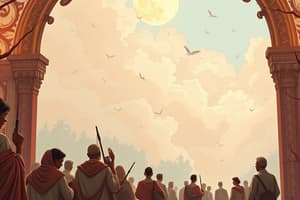Podcast
Questions and Answers
Which of the following best describes the script used for writing Bengali?
Which of the following best describes the script used for writing Bengali?
- An alphabetic system
- An abugida (correct)
- A logographic system
- A syllabary
What is the typical word order in Bengali grammar?
What is the typical word order in Bengali grammar?
- Subject-object-verb (SOV) (correct)
- Verb-subject-object (VSO)
- Object-subject-verb (OSV)
- Subject-verb-object (SVO)
Which of the following poets is NOT associated with Bengali literature?
Which of the following poets is NOT associated with Bengali literature?
- Michael Madhusudan Dutta
- Gabriel García Márquez (correct)
- Kazi Nazrul Islam
- Rabindranath Tagore
What significant event in 1952 highlights the political importance of the Bengali language?
What significant event in 1952 highlights the political importance of the Bengali language?
Approximately how many speakers of Bengali are there globally?
Approximately how many speakers of Bengali are there globally?
Flashcards are hidden until you start studying
Study Notes
Overview
- Bengali is an Indo-Aryan language.
- Primarily spoken in Bangladesh and the Indian state of West Bengal.
- It is the seventh most spoken language in the world.
Linguistic Features
- Script: Written in the Bengali script, which is an abugida.
- Phonetics: Rich in vowels and consonants, with a complex system of nasal sounds.
- Grammar: Subject-object-verb (SOV) order; use of postpositions instead of prepositions.
Dialects
- Major dialects include Standard Bengali, East Bengali, and West Bengali.
- Variations in pronunciation and vocabulary depending on the region.
Literature and Poetry
- Home to a rich literary tradition, including famous poets like Rabindranath Tagore and Kazi Nazrul Islam.
- Notable for its contribution to both modern and classical literature.
Cultural Significance
- Bengali culture is celebrated through festivals such as Pohela Boishakh (Bengali New Year).
- Rich traditions in music, dance, and cuisine, reflecting the language's cultural roots.
Demographics
- Approximately 230 million speakers globally.
- Majority live in Bangladesh, with significant populations in India, the UK, and the USA.
Educational Context
- Bengali is a medium of instruction in many schools and universities in Bangladesh and West Bengal.
- Language movements, particularly the Language Movement of 1952 in Bangladesh, highlight its political and cultural importance.
Current Status
- Continues to evolve with influences from globalization and technology.
- Efforts are ongoing to preserve and promote the language in the digital age.
Overview
- Bengali is an Indo-Aryan language, primarily spoken in Bangladesh and the Indian state of West Bengal.
- It ranks as the seventh most spoken language worldwide, with a significant number of native speakers.
Linguistic Features
- Uses an abugida writing system known as the Bengali script.
- Possesses a diverse array of vowels and consonants, featuring a complex nasal sound system.
- Follows a Subject-Object-Verb (SOV) grammatical structure and employs postpositions instead of prepositions.
Dialects
- Major dialects include Standard Bengali, East Bengali, and West Bengali, each exhibiting distinct pronunciation and vocabulary variations based on regional differences.
Literature and Poetry
- Rich literary tradition characterized by prominent figures such as Rabindranath Tagore and Kazi Nazrul Islam.
- Contributions to both modern and classical literature highlight the language's depth.
Cultural Significance
- Bengali culture is vibrant, celebrated through festivals like Pohela Boishakh (Bengali New Year).
- The language is intertwined with rich traditions in music, dance, and cuisine, showcasing its cultural roots.
Demographics
- Approximately 230 million speakers globally, predominantly in Bangladesh, with considerable populations in India, the UK, and the USA.
Educational Context
- Bengali serves as a medium of instruction in numerous schools and universities in Bangladesh and West Bengal.
- The Language Movement of 1952 in Bangladesh underscores the language's political and cultural significance and its impact on national identity.
Current Status
- The language is evolving, influenced by globalization and technological advances.
- Ongoing efforts aim to preserve and promote Bengali, especially in the digital landscape.
Studying That Suits You
Use AI to generate personalized quizzes and flashcards to suit your learning preferences.



